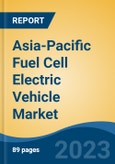Asia Pacific Fuel Cell Electric Vehicle Market is anticipated to have a high growth rate due to the rising concern over the environment; countries are adopting clean energy fuel and enhancing the emission norms of vehicles.
Speak directly to the analyst to clarify any post sales queries you may have.
10% Free customizationThis report comes with 10% free customization, enabling you to add data that meets your specific business needs.
Development in Infrastructure by Government
South Korea announced plans to construct the largest liquid hydrogen facility in the world in May. The country's chemical-focused conglomerate Hyosung Group signed a contract with Linde for a USD 244 million project to construct the plant by 2022 with a capacity of 13,000 mt/year.Japan's prominence at the Tokyo 2020 Olympics demonstrates its dedication to hydrogen. Tokyo 2020's 'Hydrogen Olympics' will see hydrogen utilized to power the Olympic Cauldron during the opening ceremony. Additionally, the Olympic Village utilizes hot water in the cafeterias, dorms, and training facilities, as well as athlete buses and vehicles that are hydrogen-fueled. During the Olympics, a total of 500 hydrogen-powered fuel cell vehicles were used. By 2030, Japan plans to build 1,000 hydrogen recharging stations for fuel-cell cars.
Developments by Manufacturers in Fuel Cell Vehicles
The Mirai sedan was unveiled by Toyota Motor Corp. globally. In March 2021, Hyundai Motor Co. introduced its Nexo crossovers and Tucson globally.The Clarity Fuel Cell from Honda Motor Co. Ltd. is available for leasing, while the GLC F-CELL from Daimler AG has already been delivered to a small number of business and government clients. Several Chinese manufacturers, including the state-owned SAIC Motor, have created their own buses.
Two new zero-emission buses, the F12 Hydrogen Fuel Cell Bus, and the C11pure Electric Bus, were introduced in Beijing by Yuan Cheng, a subsidiary brand of Geely New Energy Commercial Vehicle Group (GCV).
Increasing Demand in Fuel Cell Vehicles
There is an increasing demand for fuel cell vehicles because they produce less carbon emission, have high efficiency, and low operating cost. Also, fuel cell vehicles provide a high range of traveling and produce more power than battery-electric vehicles. To promote the use of hydrogen fuel cells, the government has standardized to reduce carbon emissions. Because hydrogen fuel cells produce heat and water vapor as byproducts, there is a great need for hydrogen fuel cells that don't produce any toxic gases. It has benefits to switch from gasoline to hydrogen fuel cells, and hydrogen fuel cells also perform better.Improved Range and Efficiency Due to Technological Advances
Due to its enhanced performance, quicker refilling, and longer range, fuel cell vehicles have become more and more popular in recent years. The technique also produces lower pollutants and, in addition to these benefits, helps in more power and torque. In addition, current catalyst innovations are essential for the development of fuel cell technology since they will increase durability through creative catalyst layer designs. Thus, the market for fuel-cell electric vehicles can be expected to increase significantly because of ongoing technological developments in fuel-cell technology.Infrastructure, Price, and Safety Concerns
One of the major challenges in the adoption of fuel cell vehicles is the infrastructure for charging stations and the high prices of the vehicle. Many OEMs are building charging stations so the consumer has access to efficient charging along the way. Also, the consumers are concerned about the charging as they are worried about between stoppage of the vehicle. Hydrogen fuel cell products have greater transportation and storage expenses than gasoline-based goods. More safety issues are associated with hydrogen because it is flammable.Market Segmentation
The Asia-Pacific Market is segmented by vehicle type, fuel type, battery capacity, and region. Based on vehicle type, the market is segmented into Passenger cars, Light Commercial vehicles, and Medium & Heavy Commercial vehicles. Based on fuel type, the market is segmented into Methanol and Hydrogen. On the basis of battery capacity, the market is segmented into 0 kWh to 100 kWh, 101 kWh to 200 kWh, and above 200 kWh.Company Profiles
Toyota Motor Corporation, Hyundai Motor Company, Honda Motor Co., Ltd. General Motor Company, Nissan Motor Corporation, Tata Motors Limited, Mitsubishi Motors Corporation, Mercedes Benz AG, SAIC Motor Corporation Limited, and Zhejiang Geely Holding Group Co., Ltd are the key players developing advanced technologies to stay competitive in the market and enhancing their product portfolio in the region to increase their customer outreach.Report Scope:
In this report, APAC Fuel Cell Electric Vehicle Market has been segmented into the following categories, in addition to the industry trends, which have also been detailed below:Asia Pacific Fuel Cell Electric Vehicle Market, By Vehicle Type
- Passenger Car
- Light Commercial Vehicle
- Medium & Heavy Commercial Vehicle
Asia Pacific Fuel Cell Electric Vehicle Market, By Fuel Type:
- Methanol
- Hydrogen
Asia Pacific Fuel Cell Electric Vehicle Market, By Battery Capacity:
- 0 kWh to 100 kWh,
- 101 kWh to 200 kWh,
- Above 200 kWh
Asia Pacific Fuel Cell Electric Vehicle Market, By Region:
- China
- Japan
- South Korea
- India
- Thailand
- Indonesia
- Malaysia
Competitive Landscape
Company Profiles: Detailed analysis of the major companies present in the Apac Fuel Cell Electric Vehicle Market.Available Customizations:
With the given market data, the publisher offers customizations according to a company’s specific needs.This product will be delivered within 1-3 business days.
Table of Contents
Companies Mentioned (Partial List)
A selection of companies mentioned in this report includes, but is not limited to:
- Toyota Motor Corporation
- Hyundai Motor Company
- Honda Motor Co. Ltd
- General Motor Company
- Nissan Motor Corporation
- Tata Motors Limited
- Mitsubishi Motors Corporation
- Mercedes Benz AG
- Siac Motor Corporation Limited.
- Zhejiang Geely Holding Group Co.








